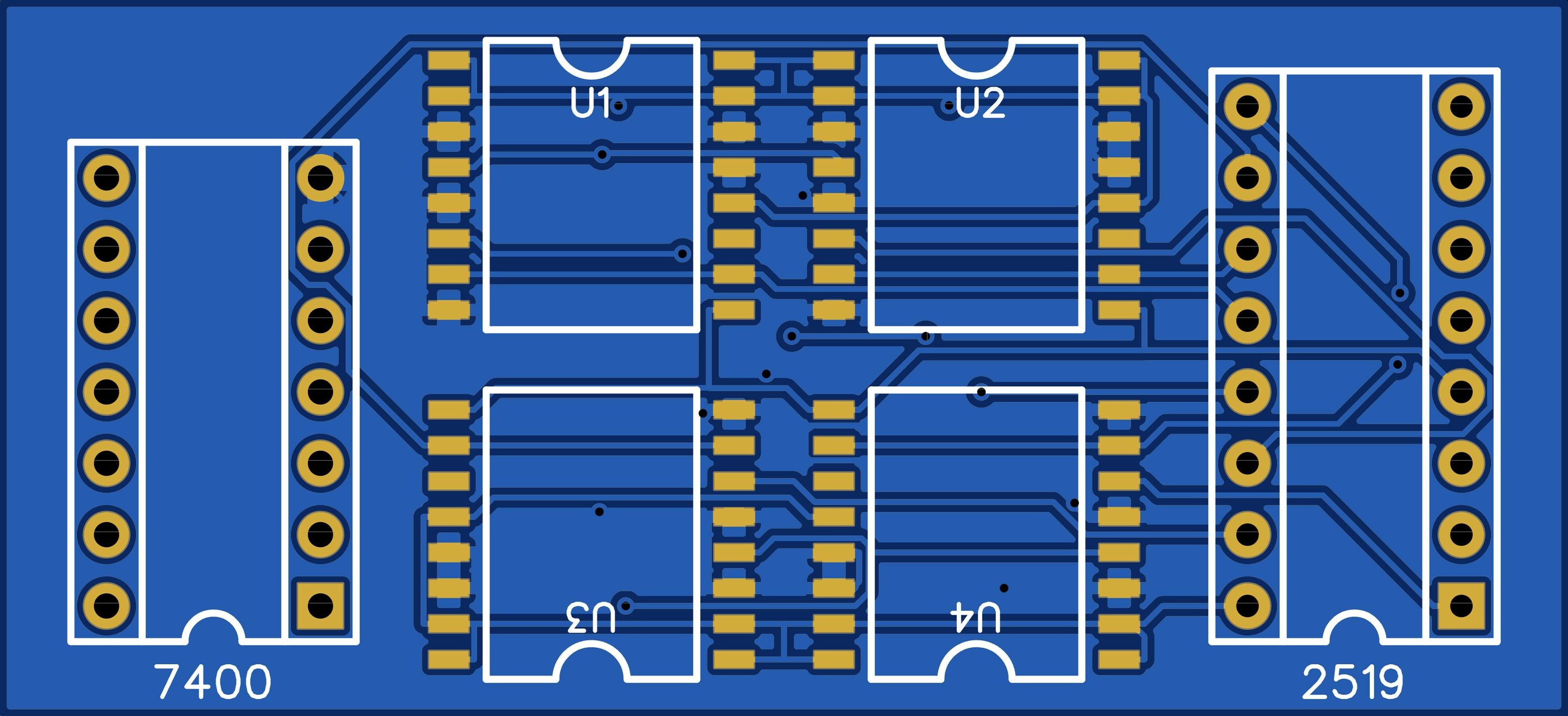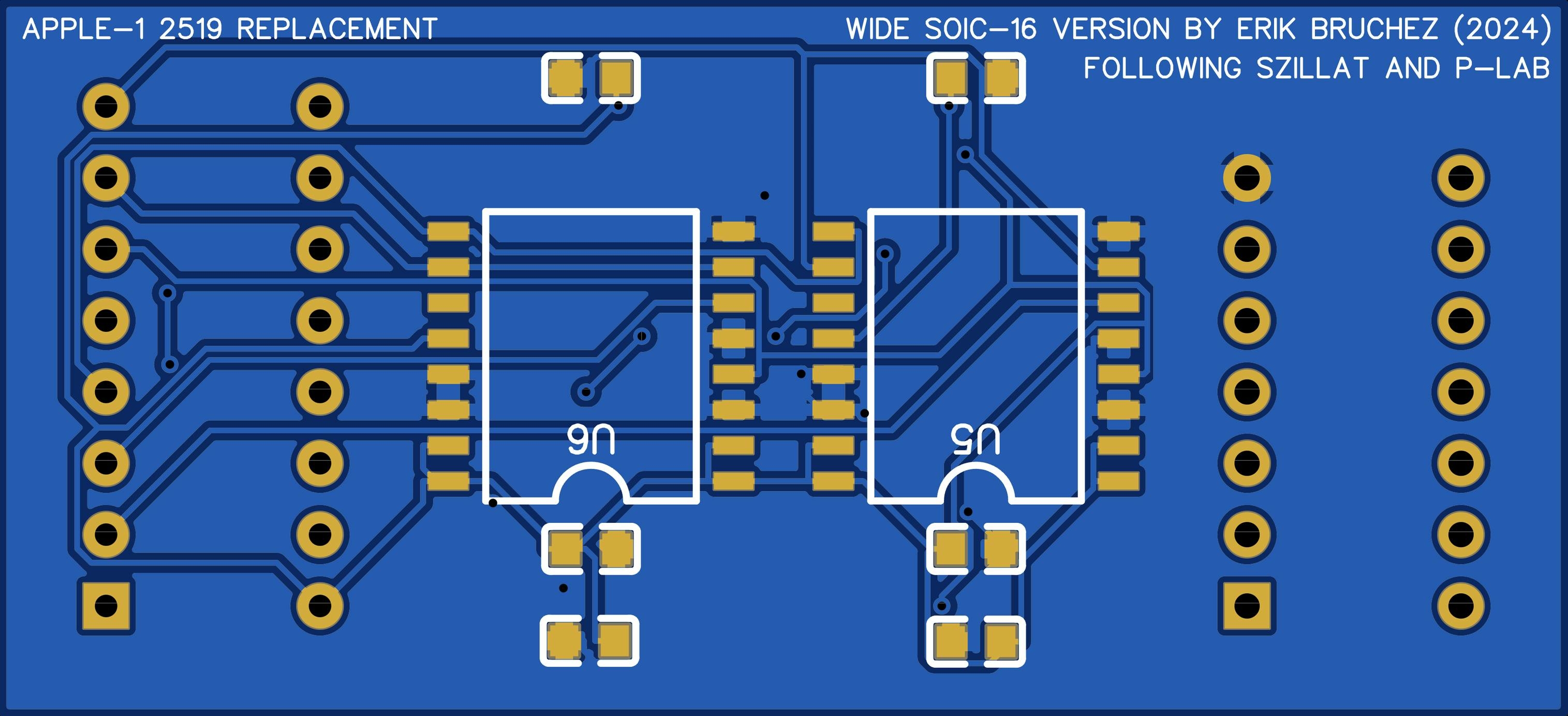For my Apple-1 build, I used the 2519 replacement board designed by Szillat and P-LAB. This worked great, but I had the issue that the small-package 14557 shift registers are not available from major electronics components stores (or only in very large quantities). I had to buy those on eBay, and they are not reliably available there either. However, the SOIC-16 Wide chips are easily available. So I recently I redesigned the board to handle the larger chips. I managed to do this without making the board larger, partly by putting all the decoupling capacitors on the opposite side.
I have now put the files in this GitHub repository. As I mentioned elsewhere, I am just starting to learn tools like EasyEDA, so this can probably be improved, but the board works fine for me so far.







Congrats to this work, it's a valuable contribution to the Apple-1 builders scene - as not everybody is willing to pay the usurious prices now being asked for real 2519.
How about "hiding" the 2519 replacement card below the motherboard ? It looks "flat" enough to do that.
The 2519 socket would stay empty but could take some "dummy", and empty DIL-16 IC package. Or some DIL-16 resistor network which is high ohmic enough to not disturb the signals in any way. If you avoid the yellow ones, and find grey or black ones, it would look - almost - right.
Here is one experiment which might be worthwhile to do: are the 14557 ICs on the substitute strong enough to overwhelm the weak output drivers of a real 2519 ? If so, this would give us the option to plug in a real but defunct 2519 into the otherwise empty socket. Just for the correct looks !
And if this does not work, there is always the possibility to manipulate the socket itself to disconnect the 2519 outputs from the PCB.
This would allow the use of original but bad Signetics 2519 to get the right looks. Nobody would see the substitute PCB hidden below the motherboard.
Comments invited ! (Assume I have a bag of bad 2519 which did not make it through my burn-in procedure).
- Uncle Bernie
Thanks. It should be possible to hide it underneath the main board. The only trick is how to connect to the underneath of the IC sockets. Ideally, you would just want IC socket will long leads, so that they would plug into sockets mounted on the replacement board. Maybe wire-wrapping sockets could work?
Wire-wrap posts are much thicker than IC leads, and also sharp: they will damage IC sockets. There may be special "mezzanine" or "stacking" sockets designed for wire-wrap posts, or they could just be soldered.
In post #3, 'ebruchetz' wrote:
" Ideally, you would just want IC socket will long leads, so that they would plug into sockets mounted on the replacement board. Maybe wire-wrapping sockets could work? "
Uncle Bernie answers:
As 'robespierre' wrote in post #4, wire wrap sockets don't plug well into normal IC sockets, as the wire wrap posts are too large.
The "mezzanine" socket adpaters once did exist, they look like normal IC sockets but have pins on both sides, one side has a larger diameter and was meant to be soldered into the mezzanine PCB, and the other side has a smaller diameter which was meant to be plugged into a regular IC socket - the smaller diameter being necessary to avoid overstressing of the socket's spring contacts. Alas, some people get this wrong.
In post #18 of this thread you can see an example of a typical "mezzanine" socket adapter:
https://www.applefritter.com/content/how-important-are-iwm-features-apple-iic
except that in this case, the small diameter pins were bent to be soldered SMD style. Which is the wrong way, because now only the large diameter pins are left (still straight) and these will ruin most types of regular IC sockets when they are pressed into them by brute force. But I also know that the large diameter pins of these "mezzanine" socket adapters are very difficult to bend. Two needle nose pliers are needed, one to to hold the pin, one to bend it, otherwise the pins will break off at the point where the diameter widens.
The small diameter pins of these adapters also are very fragile. This is why I can't recommend these adapters unless they are absolutely needed.
The solution I would adopt is to just solder 16 thin insulated wires to the motherboard (on the solder side) and then solder these to the 2519 substitute PCB.
This is cheap, requires no ordering of exotic components, and is easy to remove once an affordable 2519 is found.
- Uncle Bernie
I stand corrected regarding wire wrap sockets. Then would remain the question of finding a dummy or at least innocuous 2519 chip to put on top, for looks.